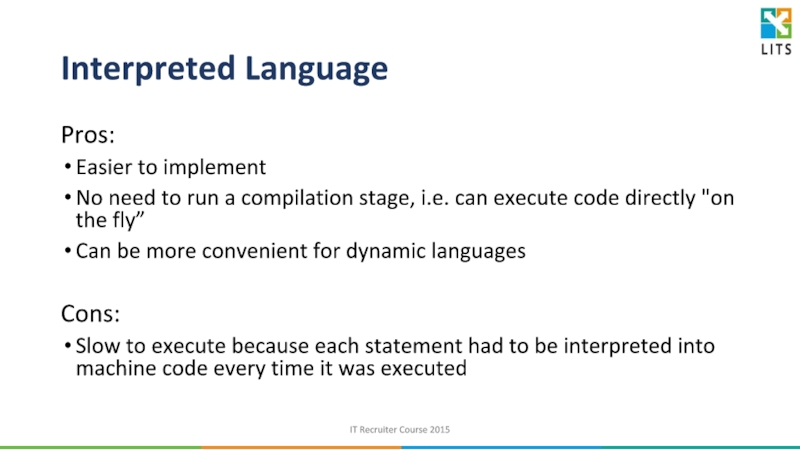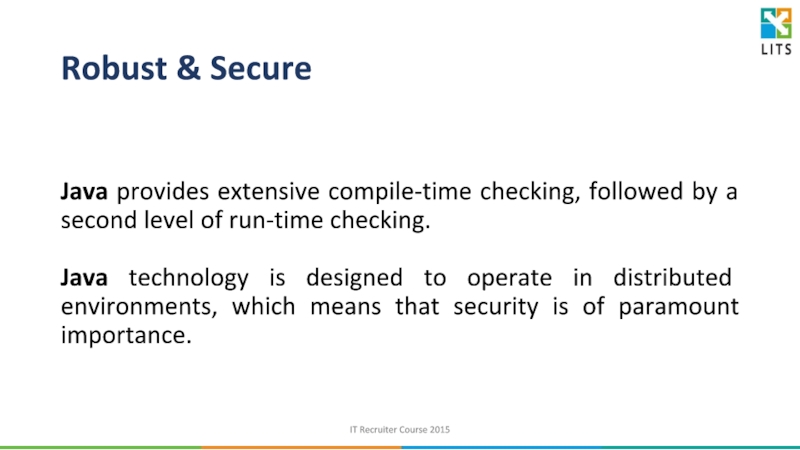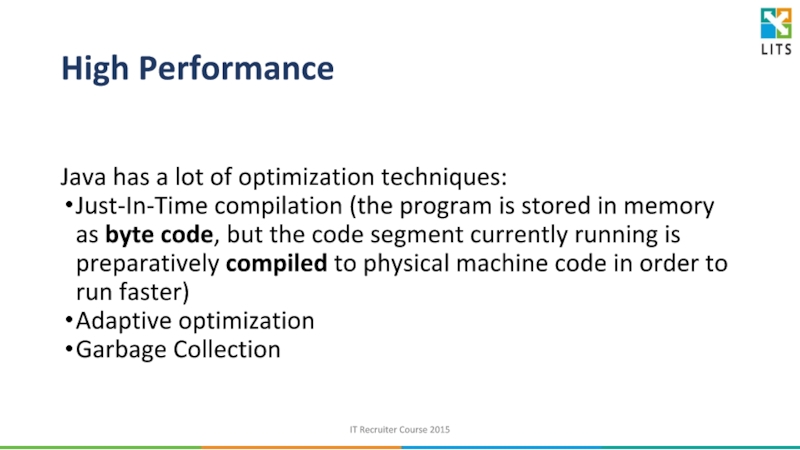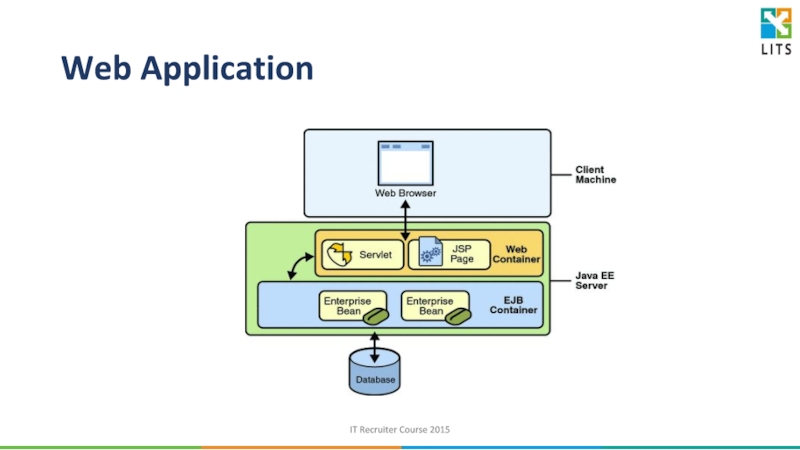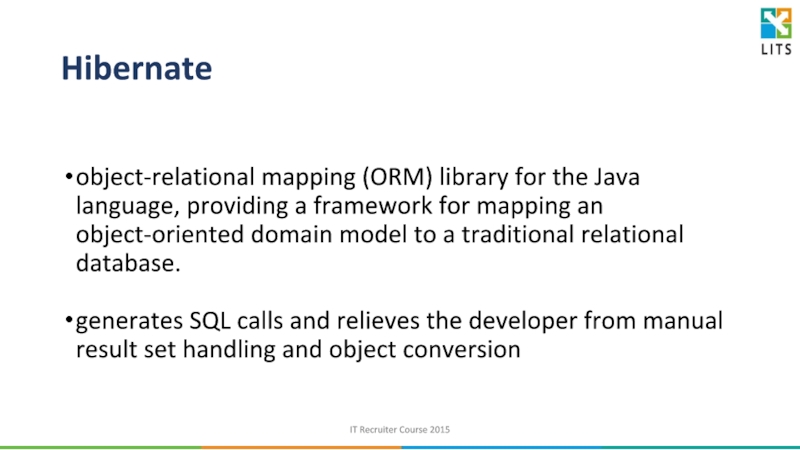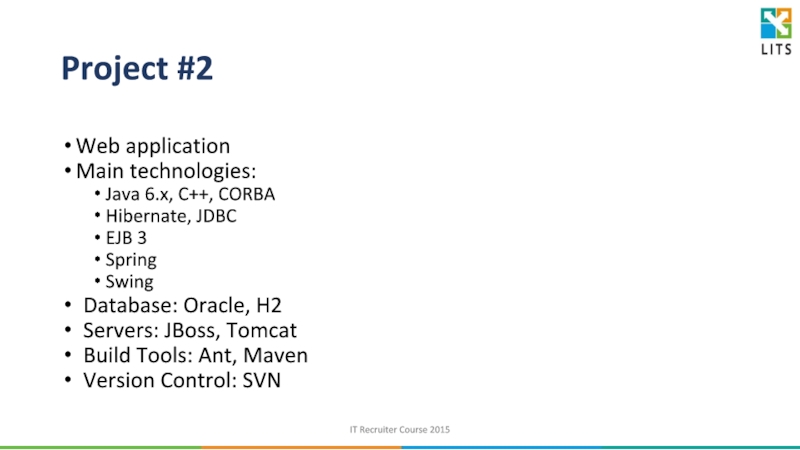- Главная
- Разное
- Дизайн
- Бизнес и предпринимательство
- Аналитика
- Образование
- Развлечения
- Красота и здоровье
- Финансы
- Государство
- Путешествия
- Спорт
- Недвижимость
- Армия
- Графика
- Культурология
- Еда и кулинария
- Лингвистика
- Английский язык
- Астрономия
- Алгебра
- Биология
- География
- Детские презентации
- Информатика
- История
- Литература
- Маркетинг
- Математика
- Медицина
- Менеджмент
- Музыка
- МХК
- Немецкий язык
- ОБЖ
- Обществознание
- Окружающий мир
- Педагогика
- Русский язык
- Технология
- Физика
- Философия
- Химия
- Шаблоны, картинки для презентаций
- Экология
- Экономика
- Юриспруденция
Computer Programming Essentials| Java | Java Technologies презентация
Содержание
- 1. Computer Programming Essentials| Java | Java Technologies
- 2. Agenda Computer Programming Compilation vs. Interpretation History
- 3. Computer Programming Compilation vs. Interpretation IT Recruiter Course 2015
- 4. Computer Programming Programming – process that leads
- 5. Computer Programming Creating a sequence of instructions
- 6. Computer Programming Algorithm The algorithm is often
- 7. Compilation Translation of source code into machine code IT Recruiter Course 2015
- 8. Compiled Language A compiled language is one
- 9. Interpreted Language An interpreted language is one
- 10. Compiler vs. Interpreted IT Recruiter Course 2015
- 11. Compiler Language Pros: Faster performance by directly
- 12. Interpreted Language Pros: Easier to implement No
- 13. Why is This Important to Recruiter? Programming
- 14. Java History of Java. Main Features of
- 15. History of Java Java language was originally
- 16. Main Features There were 5 primary goals
- 17. Simple, Object-oriented and Familiar Java can be
- 18. Robust & Secure Java provides extensive compile-time
- 19. Architecture Neutral and Portable Java is intended
- 20. Architecture Neutral and Portable Java applications are
- 21. Architecture Neutral and Portable IT Recruiter Course 2015
- 22. High Performance Java has a lot of
- 23. High Performance Java performance is generally: slower
- 24. Java Development Kit JDK contains tools for
- 25. Java Version History JDK Alpha and Beta
- 26. Java Platform Consists of distinct, but interrelated
- 27. Java Platform Editions Java Card – a
- 28. Java Platform Editions Java SE (Standard Edition)
- 29. Why is This Important to Recruiter? Java
- 30. Java Technologies Servlet. JSP. JDBC. Hibernate. Swing. Spring Framework. IT Recruiter Course 2015
- 31. Web Application Java Web Application Request Handling IT Recruiter Course 2015
- 32. Web Application IT Recruiter Course 2015
- 33. Servlet Java programming language class used to
- 34. Java Server Pages technology that helps to
- 35. Java Database Connectivity (JDBC) is an API
- 36. Hibernate object-relational mapping (ORM) library for the
- 37. Swing Primary Java GUI widget toolkit IT Recruiter Course 2015
- 38. Spring Framework is an open-source application framework
- 39. Why is This Important to Recruiter? Java
- 40. Examples of Java Projects Real anonymized descriptions IT Recruiter Course 2015
- 41. Project #1 Web application with user interface
- 42. Project #2 Web application Main technologies: Java
- 43. Use real world and practice! Let us
Слайд 1Computer Programming
Essentials| Java | Java Technologies
Taras Matyashovskyy
IT Recruiter Course 2015
Слайд 2Agenda
Computer Programming
Compilation vs. Interpretation
History of Java
Main Features of Java
JDK
History of Releases
Java
Java Technologies
Examples of Java Projects
IT Recruiter Course 2015
Слайд 4Computer Programming
Programming – process that leads from an original formulation of
Usually it includes:
analysis, understanding, and generically solving such problems resulting in an algorithm
coding of the algorithm in a target programming language
testing, debugging, and maintaining the source code
IT Recruiter Course 2015
Слайд 5Computer Programming
Creating a sequence of instructions
to enable the computer to
IT Recruiter Course 2015
Слайд 6Computer Programming Algorithm
The algorithm is often only represented
in human-parseable form
Source code is written in one or more programming languages, e.g. C++, C#, Java, Python, JavaScript, etc.
IT Recruiter Course 2015
Слайд 8Compiled Language
A compiled language is one where the program, once compiled,
For example, an addition "+" operation in your source code
could be translated directly to the "ADD" instruction in machine code.
IT Recruiter Course 2015
Слайд 9Interpreted Language
An interpreted language is one where the instructions are not
For example, the same "+" operation would be recognized by the interpreter at run time, which would then call its own "add(a,b)" function with the appropriate arguments, which would then execute the machine code "ADD" instruction.
IT Recruiter Course 2015
Слайд 11Compiler Language
Pros:
Faster performance by directly using the native code of the
Opportunity to apply quite powerful optimizations during the compile stage
Cons:
writing good compilers is very hard
IT Recruiter Course 2015
Слайд 12Interpreted Language
Pros:
Easier to implement
No need to run a compilation stage, i.e.
Can be more convenient for dynamic languages
Cons:
Slow to execute because each statement had to be interpreted into machine code every time it was executed
IT Recruiter Course 2015
Слайд 13Why is This Important to Recruiter?
Programming language is just a tool,
Identity and preferences to specific programming language can sometimes explain professional philosophy of the engineer
IT Recruiter Course 2015
Слайд 14Java
History of Java. Main Features of Java. JDK. History of Releases.
IT
Слайд 15History of Java
Java language was originally developed by James Gosling at
Java has derived much of its syntax from C/C++, but it has fewer low-level facilities than either of them.
IT Recruiter Course 2015
Слайд 16Main Features
There were 5 primary goals in the creation of the
It should:
be simple, object-oriented and familiar
robust and secure
be architecture-neutral and portable
execute with high performance
be interpreted, threaded, and dynamic
IT Recruiter Course 2015
Слайд 17Simple, Object-oriented and Familiar
Java can be programmed without extensive programmer training.
The
It looks like C++ as far as possible results in it being a familiar language, while removing the unnecessary complexities of C++.
IT Recruiter Course 2015
Слайд 18Robust & Secure
Java provides extensive compile-time checking, followed by a second
Java technology is designed to operate in distributed environments, which means that security is of paramount importance.
IT Recruiter Course 2015
Слайд 19Architecture Neutral and Portable
Java is intended to let application developers “write
IT Recruiter Course 2015
Слайд 20Architecture Neutral and Portable
Java applications are compiled to byte code (.class
Byte code can run on any Java virtual machine (JVM) regardless of computer architecture.
JVM is a virtual machine, i.e. a machine running inside your real machine (Windows, Linux, Mac) written specifically for the host hardware.
IT Recruiter Course 2015
Слайд 22High Performance
Java has a lot of optimization techniques:
Just-In-Time compilation (the program
Adaptive optimization
Garbage Collection
IT Recruiter Course 2015
Слайд 23High Performance
Java performance is generally:
slower than compiled languages such as C
similar to other Just-in-time compiled languages such as C#
much faster than languages without an effective native-code compiler (JIT or AOT), such as Perl, Ruby, PHP and Python
IT Recruiter Course 2015
Слайд 24Java Development Kit
JDK contains tools for developing, debugging, and monitoring Java
javac – the Java compiler, which converts source code into Java byte code
java – the loader for Java applications, i.e. java interpreter
jar – the archiver, which packages related class libraries into a single JAR file
IT Recruiter Course 2015
Слайд 25Java Version History
JDK Alpha and Beta (1995)
JDK 1.0 (January 23, 1996)
JDK
Java 2 splits into J2SE, J2EE, J2ME
J2SE 1.2 (December 8, 1998)
J2SE 1.3 (May 8, 2000)
J2SE 1.4 (February 6, 2002)
J2SE 5.0 (September 30, 2004)
Java SE 6 (December 11, 2006)
Java SE 7 (July 28, 2011)
Java SE 8 (March 18, 2014)
Java SE 8 Update 66 (October 21, 2015)
IT Recruiter Course 2015
Слайд 26Java Platform
Consists of distinct, but interrelated technologies:
The Java Virtual Machine (JVM)
Class
The JVM languages, e.g. Java, Groovy, Scala, Closure
The APIs
The set of APIs is controlled by Sun Microsystems in cooperation with others through the Java Community Process program.
IT Recruiter Course 2015
Слайд 27Java Platform Editions
Java Card – a technology that allows small Java-based
Java ME (Micro Edition) – specifies several different sets of libraries for devices with limited storage, display, and power capacities. Often used to develop applications for mobile devices, PDAs, TV set-top boxes, and printers.
IT Recruiter Course 2015
Слайд 28Java Platform Editions
Java SE (Standard Edition) – for general-purpose use on
Java EE (Enterprise Edition) – test Java SE plus various APIs useful for multi-tier client–server enterprise applications
IT Recruiter Course 2015
Слайд 29Why is This Important to Recruiter?
Java is just an example, but
know specificity of the language he/she is hiring for
know latest version of the language, so he/she should understands relevance and freshness of the project for which he/she is hiring
use correct naming in the job description
etc.
IT Recruiter Course 2015
Слайд 30Java Technologies
Servlet. JSP. JDBC. Hibernate. Swing. Spring Framework.
IT Recruiter Course
Слайд 33Servlet
Java programming language class used to extend the capabilities of a
part of Java SE
to deploy and run servlet, a compatible web server with a servlet container, such as Apache Tomcat or Jetty, is required
IT Recruiter Course 2015
Слайд 34Java Server Pages
technology that helps to create dynamically generated web pages
JSP allows dynamic Java code to be combined with static web markup content, with the resulting page being compiled and executed on the server to deliver a dynamic document
to deploy and run JavaServer Pages, a compatible web server with a servlet container, such as Apache Tomcat or Jetty, is required
IT Recruiter Course 2015
Слайд 35Java Database Connectivity (JDBC)
is an API for the Java programming language
provides methods for querying and updating data in a database
is a part of Java SE
is oriented towards relational databases
supports multiple drivers, e.g. for MySQL, Oracle, Postgres, etc.
IT Recruiter Course 2015
Слайд 36Hibernate
object-relational mapping (ORM) library for the Java language, providing a framework
generates SQL calls and relieves the developer from manual result set handling and object conversion
IT Recruiter Course 2015
Слайд 38Spring Framework
is an open-source application framework and inversion of control container
has become popular in the Java community as an alternative to the Enterprise JavaBean (EJB) model used in JEE Platform
has a lot of modules
IT Recruiter Course 2015
Слайд 39Why is This Important to Recruiter?
Java technology stack is just an
read and understand candidate’s technical profile
understand high-level project requirements
read, understand and/or write correct job description
etc.
IT Recruiter Course 2015
Слайд 41Project #1
Web application with user interface
Main technologies:
Java 6.x, Javascript
JDBC, Hibernate
Spring 3.x
Spring
Spring RESTful services
HTML/CSS/JS, JQuery, Raphael.js, AngularJS
Database: MySQL
Servers: Jetty
Build Tools: Maven
Version Control: Git
IT Recruiter Course 2015
Слайд 42Project #2
Web application
Main technologies:
Java 6.x, C++, CORBA
Hibernate, JDBC
EJB 3
Spring
Swing
Database: Oracle,
Servers: JBoss, Tomcat
Build Tools: Ant, Maven
Version Control: SVN
IT Recruiter Course 2015
Слайд 43Use real world and practice!
Let us find something interesting
on DOU.ua,
IT Recruiter Course 2015











